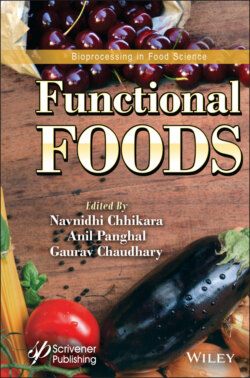Читать книгу Functional Foods - Группа авторов - Страница 45
3.2.7 Brown Rice
ОглавлениеOryza sativa L., or rice, is the cereal grain cultivated most heavily on a global level [201–203], being grown in more than 100 countries [204, 205]. In rice cultivation, the ability to use soils that have different temperatures, various levels of moisture from dry conditions to marshiness, and many different textures, such as muddy or sandy, ensures that rice remains a producible cereal worldwide [206, 207]. Over 90% of all rice globally produced is grown and processed in Asia. Rice is a livelihood for 2.5 billion people [205, 208], and it constitutes the main source of sustenance for almost 50% of the global population [202, 203]. It is primarily produced for consumption by humans, which is the destiny of over 80% of all produced rice, and it is less commonly used as an animal feed [207, 209].
The production of brown rice occurs with the dehulling of rough rice. It comprises layers of 6%–7% bran layers and 2%–3% embryo, with a large majority of approximately 90% being constituted by the endosperm [202, 210]. White rice is also known as polished rice, procured by the removal of bran from brown rice. Although slight variations exist according to the degree of milling, white rice is essentially understood to be composed of only endosperm [207, 209].
The composition of brown rice has been reported by Zhou and Zhang (2002) [211] as protein (7.1–13.1 μg/g), crude fat (1.8–4.0 μg/g), crude fiber (0.2–2.6 μg/g), vitamin A (0.1 μg/g), vitamin B1 (2.1–4.5 μg/g), vitamin B2 (0.4–0.9 μg/g), vitamin B (0.005 μg/g), vitamin E (13 μg/g), nicotinic acid (44–62 μg/g), pyridoxol (1.6–11.2 μg/g), pantothenic acid (6.6–18.6 μg/g), biotin (0.06–0.13 μg/g), total inositol (1194–1220 μg/g), free inositol (24–45 μg/g), choline (1120–1220 μg/g), and folic acid (0.20–0.60 μg/g). The mineral substances of brown rice are 65–400 μg/g Ca, 203–275 μg/g Cl, 7–54 μg/g Fe, 13–42 μg/g Mn, 2500–4400 μg/g P, 1200–3400 μg/g K, 31–176 μg/g Na, and 15–22 μg/g Zn [205]. Brown rice has higher ratios of fundamental nutrients than its white counterpart. Also, it contains extra bioactive compounds like γ-oryzanol, ferulic acid, and gammaaminobutyric acid that are primarily found in the germ and in the bran layers [205, 206, 212]. In spite of its considerable nutritional value, brown rice is less likely to be consumed than white rice is on account of its rougher texture, lower digestibility, an off-putting bran odor, and longer cooking times [205–207, 213]. To overcome these negative features, the consumption of germinated brown rice can stand out [207].
Brown rice is a favorite of both standard diets and special diets prepared for individuals afflicted by celiac disease and/or those who are intolerant to other grains. Besides its nutritional value, brown rice is one of the excellent functional foods because it reduces risks of various chronic diseases and has a positive impact on overall health [214]. Scientific research has confirmed the health-promoting activities of brown rice, such as alleviation of pain and anxiety, standardization of both blood pressure and heart rate, suppression of liver damage, improvement of autonomic disorders and sleeplessness related to presenile or menopausal periods, inhibition of cancer cell proliferation, reduction of diabetes risk, and protection against oxidative stress [214–217].
